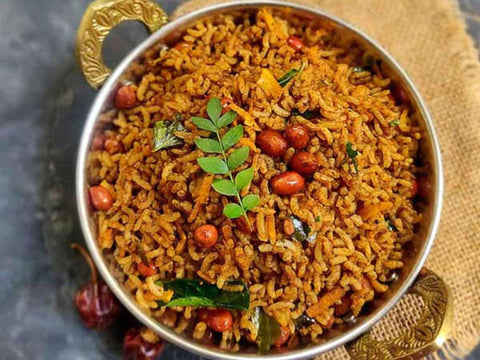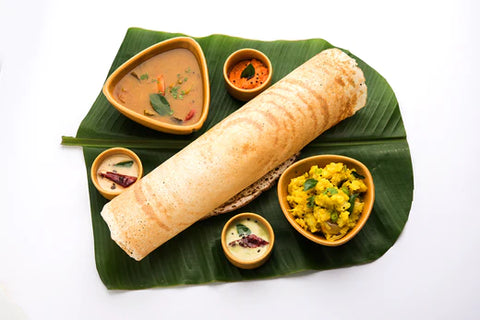Spicy, savoury, sweet, and sour- a bowl of puliyogare is a burst of flavours, in perfect harmony with one another. Puliyogare for the Kannadigas, Pulisaadham or Puliyodhara for Tamilians, Pulihora for Telugites and Ambil Bhath for the Maharashtrians, this simple tamarind rice holds a special place in our cuisine.
It has always been the perfect companion on long journeys, a complete meal and a quick fix when you want something satisfying to eat. There is one more thing about the puliyogare that almost every South Indian can relate to.
Remember that serving of aromatic puliyogare served in areca leaf bowls in temples? There is something magical about the taste of temple puliyogare, wouldn’t you agree? It is no wonder that it is such an essential part of rituals, particularly in the holy temple of Tirupati.
The Perfect Offering
Puliyogare is satvik, made with simple ingredients like tamarind, rice, peanuts and chillies. That is one of the reasons why it is chosen as an offering to the Lord in many temples across South India.
Of course, with long lines of devotees awaiting prasadam, this is one of the easiest dishes to prepare quickly in long quantities. The basic ingredients are also readily available in most parts of South India. And, it retains that fresh taste for almost two days, given the right weather conditions.
And, the taste is so divine that even the Gods cannot resist the humble puliyogare. Don’t believe us? Here is an interesting ritual that will change your mind.
The Tale of the Tiruppavada Seva
Every Thursday, the Tiruppavada Seva is performed in Tirupati. After the morning puja, the deity is draped in a Dhoti and Uttareeyam. Then, the temple comes alive with the chanting of mantras during which the application on the forehead, or the naama, is wiped off and reduced in size.
This results in something unique. The eyes of the deity, which are usually covered by the naama, become visible. Devotees gather from across the country to witness this. It is known as the Netra Darshan.
It is believed that the first gaze of the Lord when the eyes open is so powerful that we mortals cannot endure it. So, the priests perform an Annakutotsavam. In a rectangular, gold vessel placed directly in front of the deity, heaps of puliyogare are poured in. That way, the first gaze falls on this delicious offering instead of the devotees. The rice acts like a veil, also known as Paavada in Tamil, and protects the devotees.
Then, the rice is distributed to devotees as prasadam or blessings.
As you can see, puliyogare is not just another dish in South Indian cuisine. It is an integral part of our culture. Some believe that it has been around since the 3rd Century BC. It is also mentioned in the ancient anthology, Agananooru, in the verses of a nameless poet.
Whether it is to relive your childhood memories or just enjoy the taste of this traditional South Indian tamarind rice, Adukale’s Puliyogare Mix is a perfect choice. Have you tried our authentic recipe yet?




